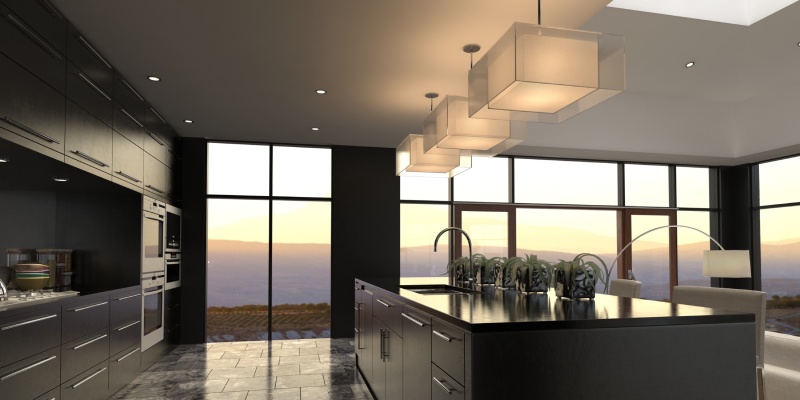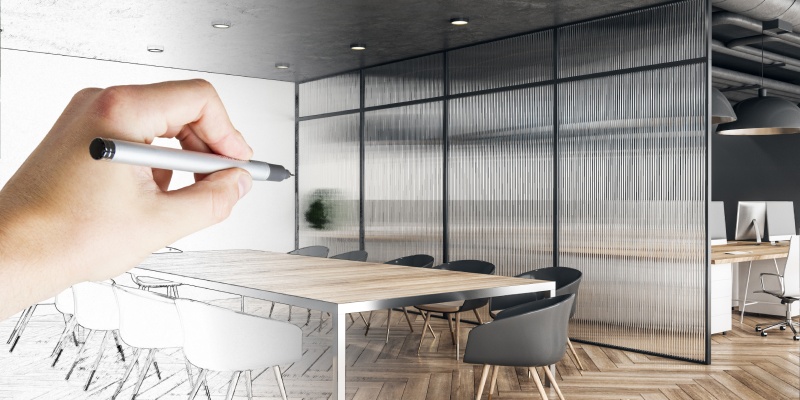Switchable glass, also known as smart glass or privacy glass, has revolutionized the fields of architecture and interior design. This innovative technology allows glass to change its appearance, transparency, or translucency at the touch of a button. Let’s delve into the fascinating world of switchable glass in Architecture and Interior Designing and explore its applications, benefits, challenges, and future trends.
Introduction to Switchable Glass

It is a cutting-edge material that can alter its properties, primarily transparency, in response to external stimuli. In architecture and interior designing, it has become a game-changer due to its dynamic nature. Architects and designers now have the ability to control the amount of light, heat, and privacy within a space, offering unprecedented flexibility.
Types of Switchable Glass Used in Architecture and Interior Designing
- Electrochromic Glass:
- It utilizes an electrochemical process to change its colour and transparency.
- Ideal for dynamic control of daylight and heat.
- Liquid Crystal Glass:
- Contains liquid crystals that align to allow light to pass or scatter to create opacity.
- Provides immediate privacy with a simple flick of the switch.
- Suspended Particle Device (SPD) Glass:
- Uses microscopic particles suspended in a liquid to control the amount of light passing through.
- Provides quick transitions between transparency and opacity.
- Thermochromic Glass:
- Responds to temperature changes, becoming darker in response to higher temperatures.
- Perfect for climate-responsive design.
Benefits Of Switchable Glass in Architecture and Interior Designing

Let’s explore the Benefits of Switchable glass in Architecture and Interior Designing:
Energy Efficiency
This glass plays a pivotal role in energy conservation by dynamically adjusting the amount of sunlight entering a building. This feature significantly reduces the need for artificial lighting and air conditioning, contributing to sustainable building practices.
Privacy Control
Architects can now design spaces with open layouts without compromising on privacy. Interchangeable glass offers the flexibility to transform transparent surfaces into opaque ones, catering to the occupants’ need for seclusion when required.
Aesthetic Versatility
The ability to control the transparency of glass opens up new possibilities in architectural design. From futuristic facades that adapt to weather conditions to interactive storefronts, the aesthetic versatility of the glass is unmatched.
Comfort and Well-being
This glass contributes to occupants’ comfort by regulating natural light. This not only enhances the overall well-being but also reduces eye strain and fatigue associated with harsh lighting conditions.
Security Enhancement
In sensitive areas, this interchangeable glass can be used to create secure zones by instantly transforming transparent windows into opaque barriers, adding an extra layer of security.
Space Optimization
For flexible spaces, this smart glass offers the advantage of adapting the layout to different needs. Large open areas can be divided or connected with ease, providing versatility in space utilization.
Applications of Switchable Glass in Architecture and Interior Designing

Here, you can check the Applications of Switchable Glass in Architecture and Interior Designing:
Smart Windows
This glass is extensively used in smart windows, allowing homeowners and commercial space occupants to control the level of natural light entering the room. This feature enhances comfort and reduces the reliance on artificial lighting.
Partition Walls
In architecture and interior design, this intelligent glass finds applications in creating dynamic and adaptable spaces. Partition walls that can change from transparent to opaque provide a unique blend of openness and privacy, catering to the evolving needs of modern living.
Innovative Lighting Solutions
The integration of this smart glass in lighting design opens up creative possibilities. From backlit switchable glass panels to interactive light installations, designers can elevate the ambience of a space.
Interactive Surfaces
This glass can be used to create interactive surfaces, transforming ordinary tables or countertops into dynamic displays. This application adds a futuristic and engaging element to both residential and commercial spaces.
Virtual Spaces
Incorporating this intelligent glass into meeting rooms or collaborative spaces allows for the creation of virtual environments. The glass can transition from transparent to opaque, creating a private atmosphere for virtual presentations or discussions.
Retail Displays
This glass is ideal for retail settings where displays can transition from transparent to opaque, adding an element of surprise and intrigue to storefronts. This application enhances the visual appeal of products and storefront design.
Hospitality Settings
In hotels and restaurants, this convertible glass can be used in various applications, including bathroom dividers, windows, and partitions. It enhances the guest experience by providing customizable levels of privacy and ambience.
Artistic Installations
This glass opens up possibilities for artistic installations in both architecture and interior design. Artists and designers can use the dynamic properties of the glass to create ever-changing visual displays and immersive environments.
Healthcare Environments
In healthcare settings, this interchangeable glass can be applied to enhance patient privacy in shared spaces. It can also be used in treatment rooms or waiting areas to create adaptable and comfortable environments.
Conclusion
In conclusion, switchable glass has emerged as a transformative element in architecture and interior designing. Its dynamic properties offer a range of benefits, from energy efficiency to aesthetic innovation. As technology continues to advance, we can expect switchable glass to become a staple in modern design, enhancing the way we interact with and experience our built environments.
FAQs
What benefits does switchable glass provide in architecture and interior design?
It contributes to energy efficiency by adjusting sunlight, enhances privacy control, offers aesthetic versatility, improves comfort and well-being through natural light regulation, enhances security, and optimizes space utilization in flexible layouts.
What are the applications of switchable glass in architecture and interior designing?
Architects and designers extensively use this glass in smart windows, partition walls, innovative lighting solutions, interactive surfaces, virtual spaces, retail displays, hospitality settings, artistic installations, and healthcare environments.
How does switchable glass contribute to energy conservation in buildings?
It aids energy conservation by dynamically adjusting sunlight, reducing the need for artificial lighting and air conditioning, aligning with sustainable building practices.
Can you use switchable glass for creating secure zones in sensitive areas?
Yes, You can use it in sensitive areas to create secure zones by instantly transforming transparent windows into opaque barriers, providing an additional layer of security.
Which types of switchable glass do architects and interior designers commonly use, and how do they differ?
Common types include electrochromic, liquid crystal, SPD, and thermochromic glass. They differ in mechanisms such as electrochemical processes, liquid crystals, microscopic particles in a liquid, and response to temperature changes.
How does switchable glass contribute to privacy control in architectural spaces?
This allows architects to design open layouts without compromising privacy. It offers the flexibility to transform transparent surfaces into opaque ones, meeting occupants’ needs for seclusion when required.





